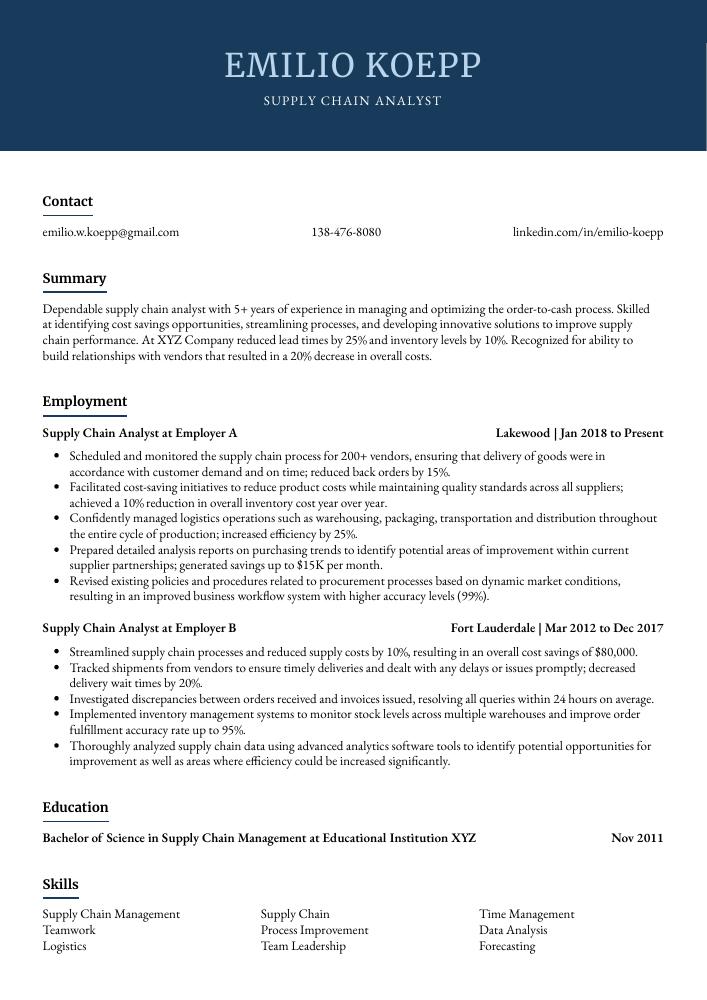Supply Chain Analyst Resume Guide
Supply chain analysts are responsible for overseeing the entire supply chain process, from production and distribution to customer service. They analyze data related to procurement, inventory management, logistics operations, and other areas of supply chain management in order to identify problems or opportunities for improvement. They also develop strategies and solutions that help companies reduce costs while improving efficiency across their supply chains.
You have the expertise and knowledge to make any supply chain run efficiently. However, employers don’t know who you are or what your strengths are yet. To let them see how valuable you would be to their business, create a resume that stands out from the competition.
This guide will walk you through the entire process of creating a top-notch resume. We first show you a complete example and then break down what each resume section should look like.
Table of Contents
The guide is divided into sections for your convenience. You can read it from beginning to end or use the table of contents below to jump to a specific part.
Supply Chain Analyst Resume Sample
Emilio Koepp
Supply Chain Analyst
emilio.w.koepp@gmail.com
138-476-8080
linkedin.com/in/emilio-koepp
Summary
Dependable supply chain analyst with 5+ years of experience in managing and optimizing the order-to-cash process. Skilled at identifying cost savings opportunities, streamlining processes, and developing innovative solutions to improve supply chain performance. At XYZ Company reduced lead times by 25% and inventory levels by 10%. Recognized for ability to build relationships with vendors that resulted in a 20% decrease in overall costs.
Experience
Supply Chain Analyst, Employer A
Lakewood, Jan 2018 – Present
- Scheduled and monitored the supply chain process for 200+ vendors, ensuring that delivery of goods were in accordance with customer demand and on time; reduced back orders by 15%.
- Facilitated cost-saving initiatives to reduce product costs while maintaining quality standards across all suppliers; achieved a 10% reduction in overall inventory cost year over year.
- Confidently managed logistics operations such as warehousing, packaging, transportation and distribution throughout the entire cycle of production; increased efficiency by 25%.
- Prepared detailed analysis reports on purchasing trends to identify potential areas of improvement within current supplier partnerships; generated savings up to $15K per month.
- Revised existing policies and procedures related to procurement processes based on dynamic market conditions, resulting in an improved business workflow system with higher accuracy levels (99%).
Supply Chain Analyst, Employer B
Fort Lauderdale, Mar 2012 – Dec 2017
- Streamlined supply chain processes and reduced supply costs by 10%, resulting in an overall cost savings of $80,000.
- Tracked shipments from vendors to ensure timely deliveries and dealt with any delays or issues promptly; decreased delivery wait times by 20%.
- Investigated discrepancies between orders received and invoices issued, resolving all queries within 24 hours on average.
- Implemented inventory management systems to monitor stock levels across multiple warehouses and improve order fulfillment accuracy rate up to 95%.
- Thoroughly analyzed supply chain data using advanced analytics software tools to identify potential opportunities for improvement as well as areas where efficiency could be increased significantly.
Skills
- Supply Chain Management
- Supply Chain
- Time Management
- Teamwork
- Process Improvement
- Data Analysis
- Logistics
- Team Leadership
- Forecasting
Education
Bachelor of Science in Supply Chain Management
Educational Institution XYZ
Nov 2011
Certifications
Certified Supply Chain Professional (CSCP)
APICS
May 2017
1. Summary / Objective
Your resume summary should be a concise and compelling introduction to your qualifications as a supply chain analyst. In this section, you can highlight the areas in which you excel – such as your ability to analyze data, identify trends, and develop strategies for optimizing efficiency. You could also mention any certifications or training courses that have helped hone your skillset, as well as any successes from previous roles that demonstrate how effective of an analyst you are.
Below are some resume summary examples:
Energetic supply chain analyst with 5+ years of experience optimizing operations and streamlining supply chains for Fortune 500 companies. Skilled in analyzing data, developing cost-effective strategies, creating SOPs, implementing process improvements, and leading cross-functional teams. Seeking to join ABC Corporation as a Supply Chain Analyst to help drive efficiencies across the organization’s global supply chain network.
Driven supply chain analyst with 5+ years of experience in developing and managing supply chain operations for global companies. Proven track record of successfully streamlining inventory management processes, reducing costs by 25%, and increasing customer satisfaction ratings by 10%. Skilled at analyzing large data sets to identify trends, develop forecasting models, and make recommendations on business process improvements.
Reliable supply chain analyst with 7+ years of professional experience in managing and optimizing supply chain operations for international companies. Adept at utilizing data-driven methodologies to identify areas of improvement, develop cost-saving strategies, and streamline processes that increase efficiency. Proven track record of producing tangible results through successful project management initiatives.
Committed supply chain analyst with 5+ years of experience in logistics and inventory control. Achieved cost savings of 15% at XYZ Corporation by optimizing their supply chain network. At ABC, implemented several successful projects to reduce lead times and improve customer service levels. Possesses strong analytical skills combined with an excellent understanding of the principles of global trade compliance.
Passionate supply chain analyst with 7+ years of experience optimizing the efficiency, accuracy, and cost-effectiveness of supply chains. Seeking to leverage knowledge in inventory management systems, forecasting techniques, and process optimization to join ABC’s team as a Supply Chain Analyst. At XYZ Inc., reduced costs by 15% through streamlining operations while increasing customer satisfaction by 32%.
Amicable supply chain analyst with 6 years of experience in streamlining operations and improving processes. Known for creating cost-efficient solutions to everyday supply chain problems, reducing costs by an estimated 20%. Seeking a position at ABC where I can apply my expertise in inventory management, logistics optimization, and process improvement to enhance the company’s overall performance.
Proficient supply chain analyst with 5+ years of experience in logistics, warehousing and inventory management. Skilled at streamlining processes to maximize efficiency and minimize costs. At XYZ Company, successfully developed a new system that reduced supply chain expenses by over 10%. Adept at analyzing complex data to identify trends and areas for improvement within the supply chain process.
Talented supply chain analyst with 5+ years of experience developing and managing supply chains for large-scale companies. Experienced in negotiating supplier contracts, optimizing inventory levels, and minimizing costs to maximize profit margins. Seeking to use my analytical skillset at ABC Inc. to increase efficiency across the entire supply chain system by 15%.
2. Experience / Employment
In the experience section, you should list your employment history in reverse chronological order. This means that the most recent job is listed first.
When writing about what you did in each role, stick to bullet points; this makes it easier for the reader to digest and understand what you are saying quickly. You want to provide detail when describing your responsibilities and accomplishments so that they can be easily understood by anyone reading them.
For example, instead of simply stating “Managed supply chain,” you could say something like: “Reduced inventory levels by 25% through improved forecasting accuracy using regression analysis.”
To write effective bullet points, begin with a strong verb or adverb. Industry specific verbs to use are:
- Analyzed
- Optimized
- Forecasted
- Monitored
- Scheduled
- Implemented
- Streamlined
- Managed
- Resolved
- Negotiated
- Collaborated
- Tracked
- Reported
- Investigated
- Coordinated
Other general verbs you can use are:
- Achieved
- Advised
- Assessed
- Compiled
- Demonstrated
- Developed
- Expedited
- Facilitated
- Formulated
- Improved
- Introduced
- Mentored
- Participated
- Prepared
- Presented
- Reduced
- Reorganized
- Represented
- Revised
- Spearheaded
- Structured
- Utilized
Below are some example bullet points:
- Presented supply chain optimization strategies to executive team, resulting in a 10% decrease in inventory costs and improved supply chain visibility.
- Reorganized warehouse operations layout for increased efficiency; decreased order fulfillment time by 20%.
- Developed forecasting models which accurately predicted demand trends, enabled the company to minimize stockouts and maintain sufficient safety stock levels of over $1M worth of products at any given time.
- Collaborated with vendors on cost-saving initiatives that reduced transportation costs by 15%, while maintaining high delivery performance standards across all suppliers/distributors.
- Substantially upgraded ERP system capabilities associated with purchase order tracking and billing processes, improving accuracy rate from 70% to 98%.
- Introduced efficient supply chain processes that resulted in a 15% cost reduction and improved order accuracy by 30%.
- Advised executive team on optimization strategies to reduce inventory costs, streamline distribution networks and enhance customer service levels.
- Reliably managed all global shipments including import/export regulations, tariff policies, customs clearance procedures and other logistical details while maintaining compliance with applicable laws & regulations.
- Forecasted monthly demand for over 1,000 products across multiple regions and developed efficient replenishment plans accordingly; successfully decreased stock-outs from 17% to 4%.
- Spearheaded the implementation of an automated shipment tracking system which drastically reduced the time taken for invoicing customers by 32 hours per month on average.
- Monitored and managed the supply chain process for 500+ products, reducing delays and inventory costs by 15%.
- Demonstrated an in-depth understanding of logistics principles and strategies to ensure reliable transportation of goods across multiple locations.
- Managed vendor relationships to secure competitive pricing on materials needed for production; saved $6,000 this quarter alone.
- Effectively tracked supplier performance against established metrics in order to improve customer service levels while ensuring quality control standards were met or exceeded at all times.
- Mentored junior team members on various supply chain techniques and best practices within the industry, increasing efficiency by 10% overall.
- Represented the supply chain department in cross-functional meetings, providing actionable insights to improve the end-to-end inventory and logistics process; led to a 25% reduction in total cost of goods sold.
- Optimized warehouse operations by formulating new strategies for efficient storage and distribution of products; successfully reduced transportation times by 45%.
- Analyzed historical data on customer demand trends, delivery cycles & supplier performance metrics to identify gaps between projected & actual costs/timescales; improved forecasting accuracy by 15%.
- Achieved an average order fill rate of 98%, exceeding monthly targets each time while maintaining highest levels of quality control across all shipments during peak periods.
- Accurately tracked inventory levels using specialized software systems, allowing management team to reduce stockouts & effectively plan resources needed for future orders with 95% accuracy rates.
- Compiled and analyzed data from multiple sources to identify cost-reduction opportunities and optimize supply chain processes, resulting in an average yearly savings of $150,000.
- Negotiated contracts with suppliers while successfully maintaining favorable business relationships; reduced supplier costs by 15% over a 3 year period.
- Assessed existing inventory management systems for accuracy and implemented process improvements that increased product availability by 30%.
- Actively monitored the movement of goods through international shipping routes to ensure timely deliveries; expedited shipments on 8 occasions which resulted in improved customer satisfaction ratings by 10%.
- Expedited key procurement activities such as vendor selection, pricing review & contract negotiations while adhering to budget constraints and established timelines across all projects.
- Participated in supply chain management and logistics processes to ensure timely delivery of goods, leading to a 14% reduction in late deliveries.
- Coordinated with vendors to source materials as per demand while also managing inventory levels; reduced average order lead time by 8 days.
- Reported on key performance indicators such as stock availability, supplier lead times and customer satisfaction scores; improved overall service rating from 7/10 to 9/10 within the first six months of joining the team.
- Reduced procurement costs by 15%, enabling an additional $20,000 savings for the organization annually through effective supply chain optimization techniques & negotiations with suppliers.
- Independently analyzed data collected from ERP systems and created detailed reports summarizing trends in sales volumes, transportation complexities & buying patterns over time.
- Formulated and executed cost-effective supply chain strategies that saved over $120,000 in annual costs.
- Resolved complex supply chain issues with suppliers and vendors within 24 hours to ensure timely shipment of materials and products.
- Utilized data analytics software for inventory optimization, resulting in a 15% increase in operational efficiency across the organization’s entire supply chain network.
- Competently managed logistical operations related to storage, transportation & distribution activities; reduced order times by an average of 22%.
- Improved supplier relationships through regular meetings and negotiations; achieved more favorable terms on contracts worth up to $300,000 per month.
3. Skills
The skillset employers require in an employee will likely vary, either slightly or significantly; skimming through their job adverts is the best way to determine what each is looking for. One organization might want someone who is proficient in SAP and another might require experience with Oracle.
It is essential to tailor the skills section of your resume for each job you are applying for, as many employers use applicant tracking systems these days which scan resumes for certain keywords before passing them on to a human.
In addition to listing relevant skills here, it may be beneficial to discuss them further in other areas such as the summary or work experience sections.
Below is a list of common skills & terms:
- Account Management
- Analysis
- Business Analysis
- Business Process Improvement
- Communication
- Continuous Improvement
- Cross Functional Team Leadership
- Customer Satisfaction
- Data Analysis
- Demand Planning
- Forecasting
- Inventory Control
- Lean Manufacturing
- Logistics
- Logistics Management
- MRP
- Manufacturing
- Materials Management
- Merchandising
- Operations Management
- Problem Solving
- Process Improvement
- Procurement
- Product Development
- Project Planning
- Purchasing
- SAP
- SQL
- Six Sigma
- Supply Chain
- Supply Chain Management
- Supply Chain Optimization
- Supply Management
- Team Leadership
- Teamwork
- Time Management
- Transportation
- Warehousing
4. Education
Including an education section on your resume will depend on how far along you are in your career. If you just graduated and have no work experience, mention your education below the objective statement of your resume. However, if you have several years of relevant work experience to showcase, it is perfectly fine to omit an education section altogether.
If an educational background is included, try mentioning courses related to supply chain analytics that can demonstrate knowledge or skills necessary for the role.
Bachelor of Science in Supply Chain Management
Educational Institution XYZ
Nov 2011
5. Certifications
Certifications demonstrate to potential employers that you have taken the time and effort to gain knowledge in a certain field. Having certifications on your resume will help show hiring managers that you are committed to staying up-to-date with industry trends, as well as having the necessary skills for the job.
If there is an important certification related to the position you are applying for, make sure it is included in this section of your resume so recruiters can quickly identify how qualified you are.
Certified Supply Chain Professional (CSCP)
APICS
May 2017
6. Contact Info
Your name should be the first thing a reader sees when viewing your resume, so ensure its positioning is prominent. Your phone number should be written in the most commonly used format in your country/city/state, and your email address should be professional.
You can also choose to include a link to your LinkedIn profile, personal website, or other online platforms relevant to your industry.
Finally, name your resume file appropriately to help hiring managers; for Emilio Koepp, this would be Emilio-Koepp-resume.pdf or Emilio-Koepp-resume.docx.
7. Cover Letter
Including a cover letter when applying for a job is highly recommended and can make all the difference in helping you land an interview. It’s usually made up of 2 to 4 paragraphs where you introduce yourself, explain your qualifications, and provide additional information about why you’re the perfect candidate for the role.
Cover letters are designed to give recruiters with more insight into who you are as a professional. They complement your resume by providing additional detail that may not have been mentioned in it – such as specific examples or accomplishments from previous roles.
Below is an example cover letter:
Dear Vladimir,
I am writing to apply for the Supply Chain Analyst position at XYZ Corporation. With my experience in data analysis, supply chain management, and project coordination, I am confident I would be a valuable asset to your team.
In my current role as a Supply Chain Analyst at ABC Corporation, I manage a team of five analysts responsible for analyzing data and developing reports to support decision-making within the supply chain department. I have also been instrumental in streamlining our process for managing supplier performance reviews, which has resulted in improved communication and more efficient use of resources.
Prior to my current role, I worked as a Project Coordinator at DEF Corporation where I coordinated cross-functional teams on large scale projects. This experience has given me the ability to effectively communicate with stakeholders at all levels and across departments, which is essential in a successful supply chain operation.
I believe my skills and experiences make me an ideal candidate for the Supply Chain Analyst position at XYZ Corporation. I look forward to speaking with you about this opportunity and thank you for your time and consideration.
Sincerely,
Emilio
Supply Chain Analyst Resume Templates
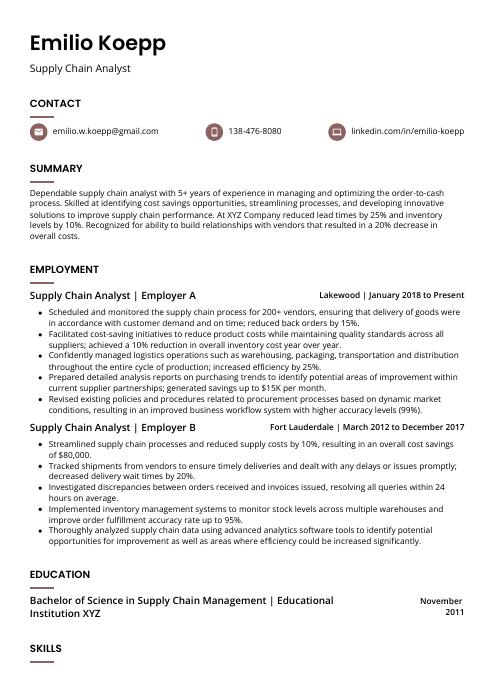 Fossa
Fossa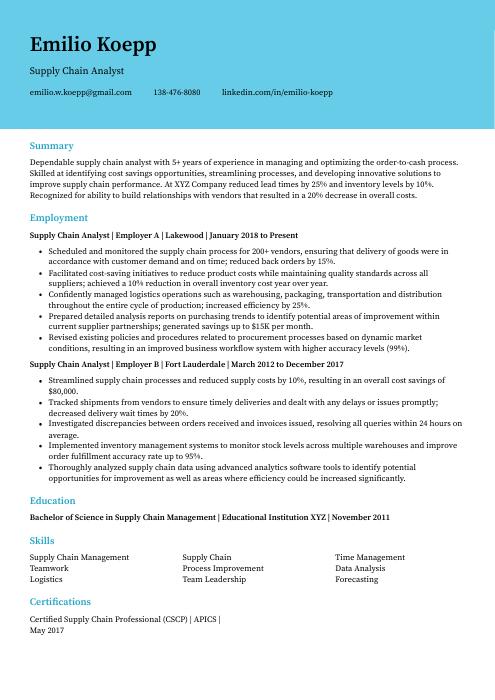 Dugong
Dugong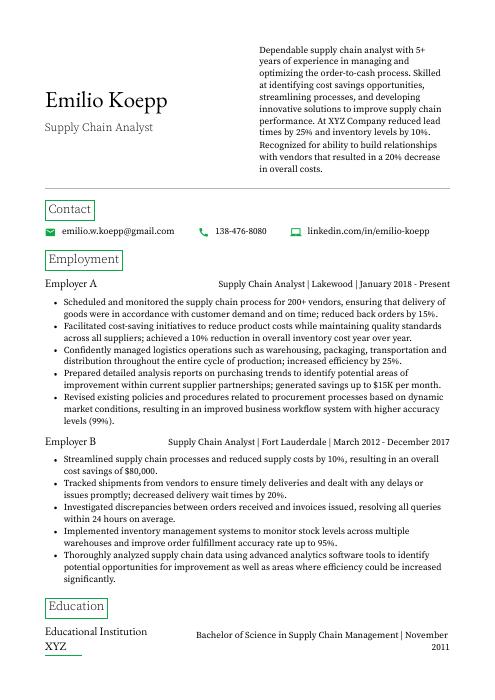 Quokka
Quokka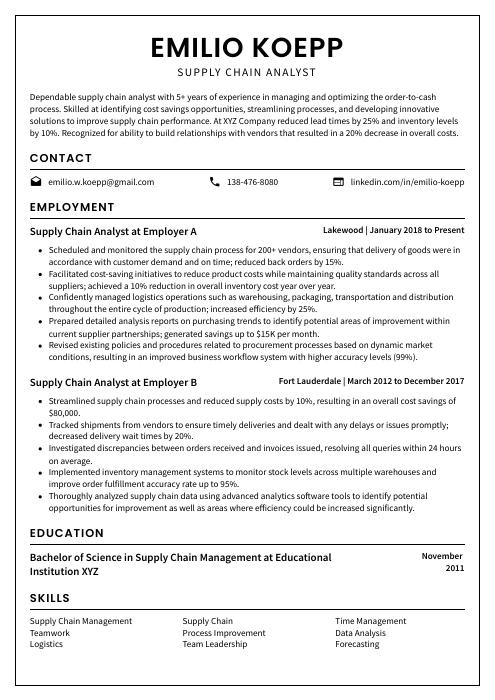 Cormorant
Cormorant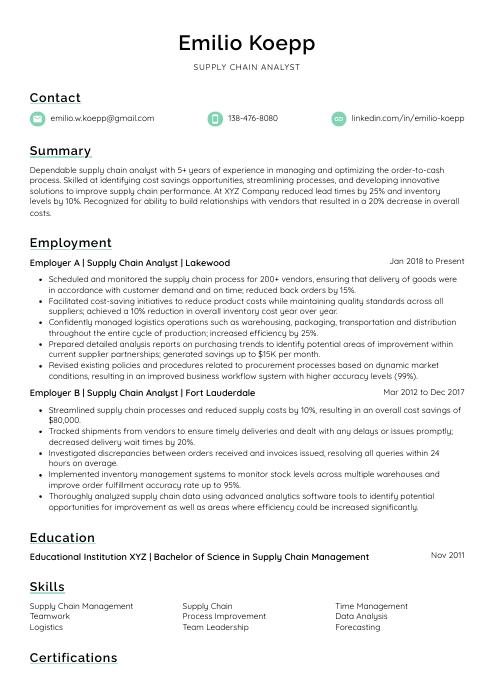 Lorikeet
Lorikeet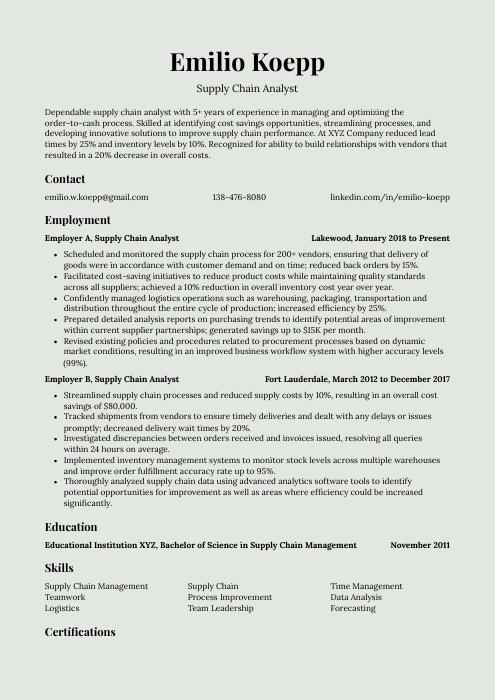 Saola
Saola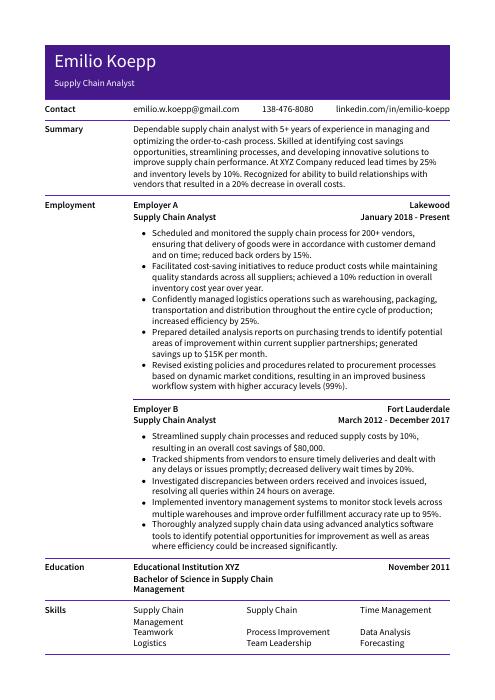 Pika
Pika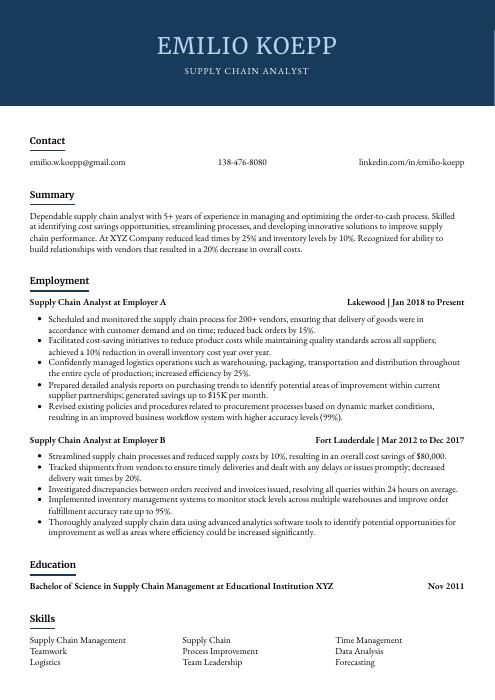 Bonobo
Bonobo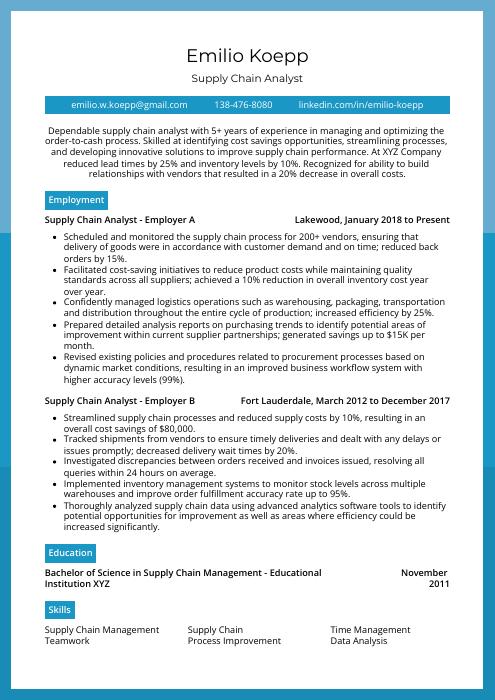 Rhea
Rhea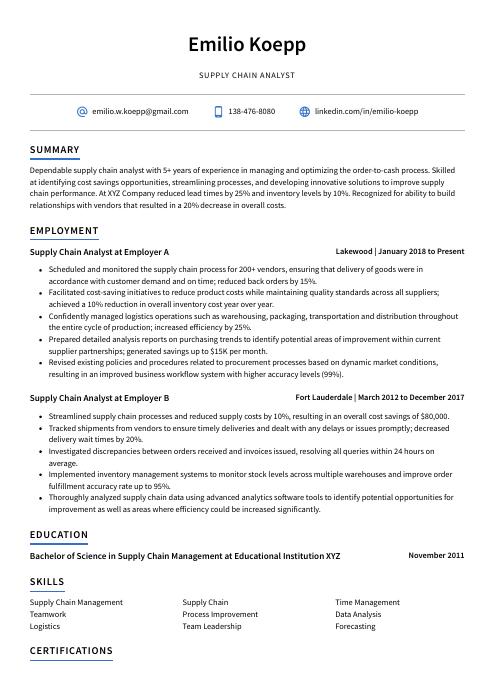 Axolotl
Axolotl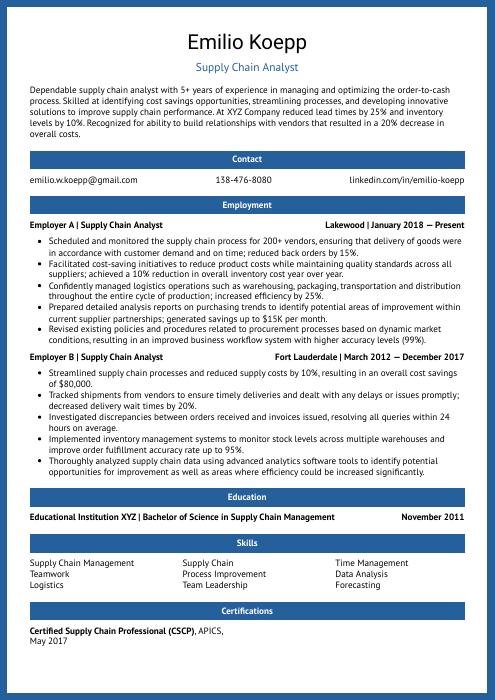 Ocelot
Ocelot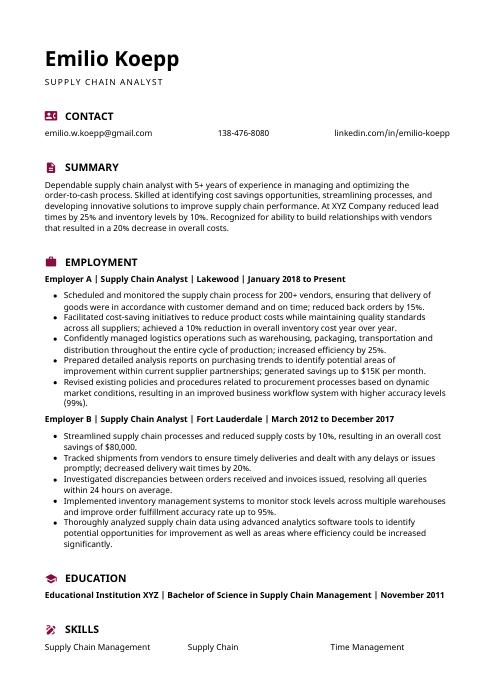 Hoopoe
Hoopoe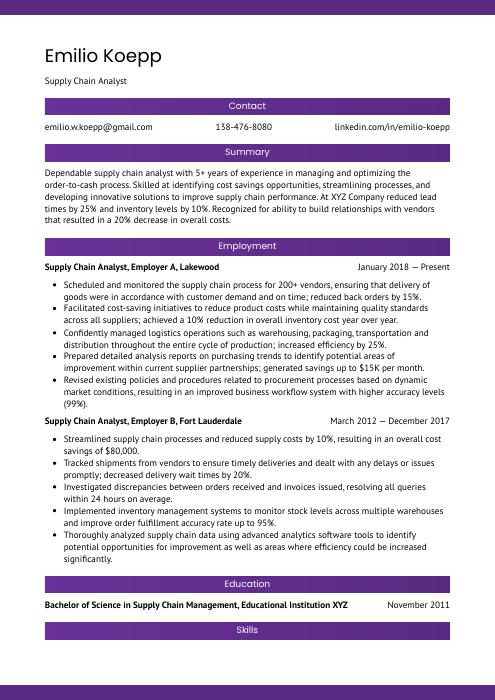 Jerboa
Jerboa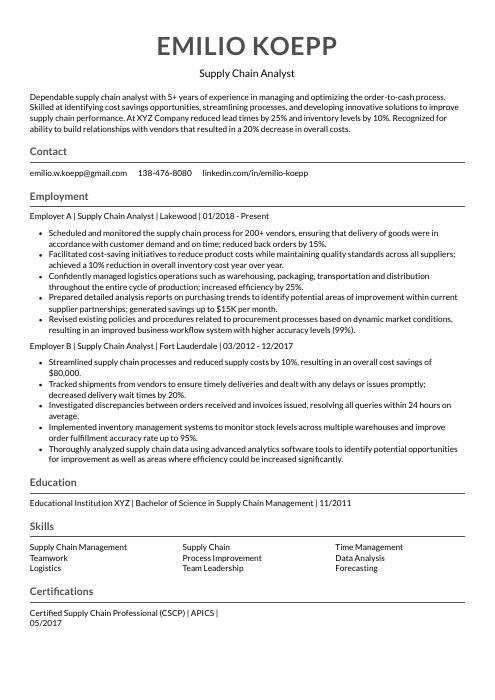 Indri
Indri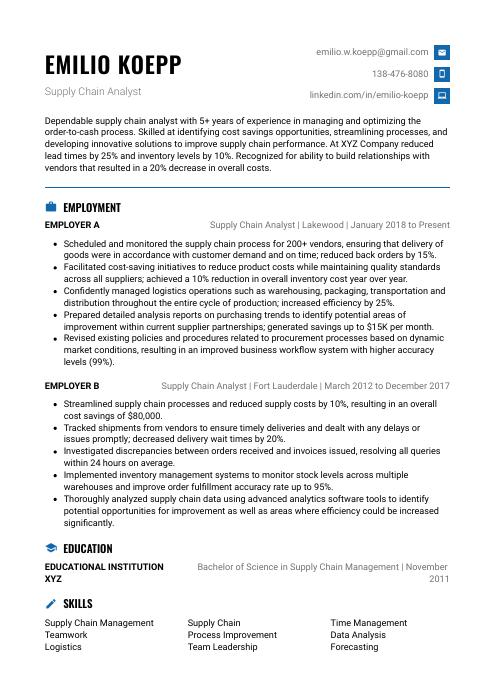 Echidna
Echidna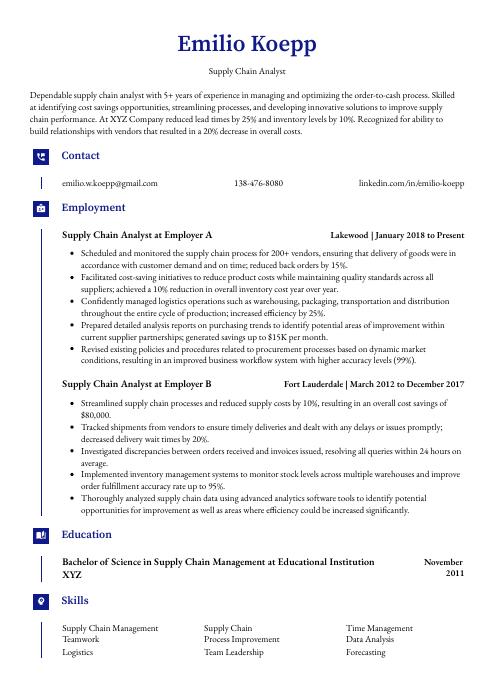 Gharial
Gharial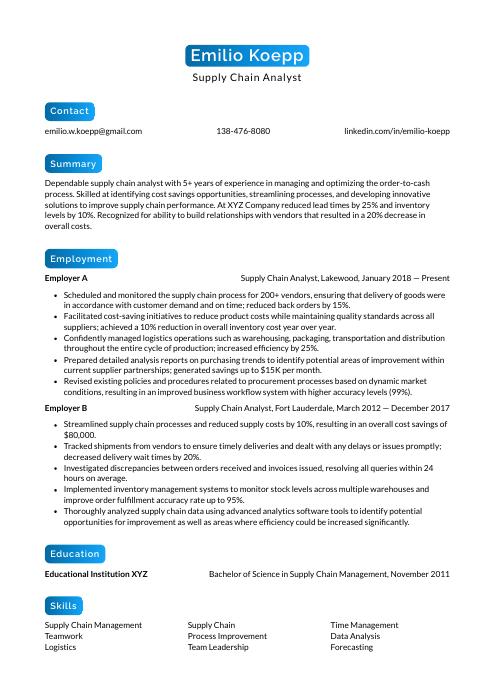 Kinkajou
Kinkajou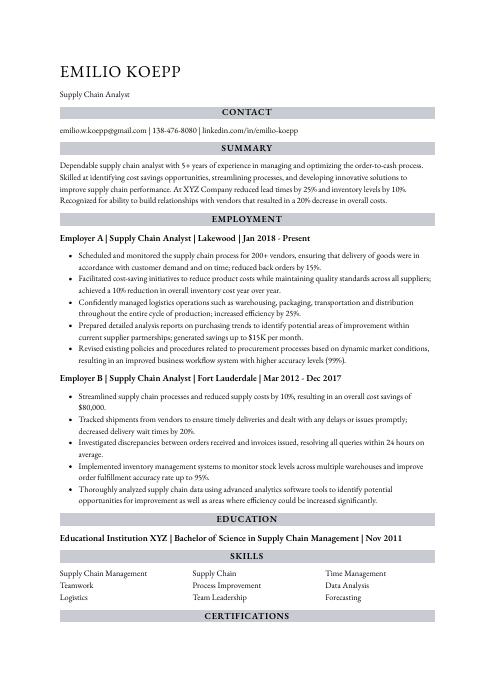 Numbat
Numbat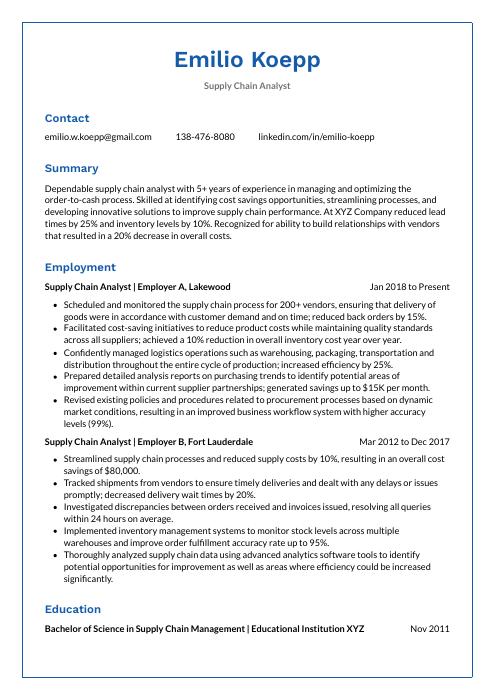 Markhor
Markhor Rezjumei
Rezjumei
